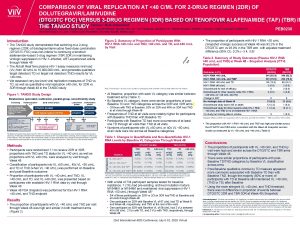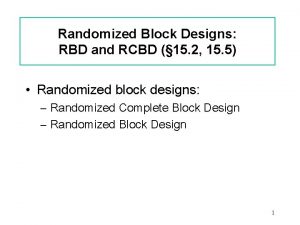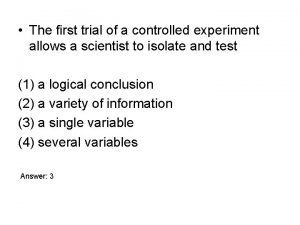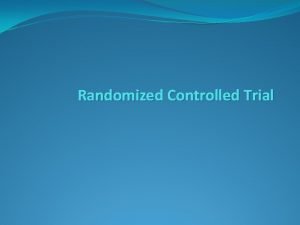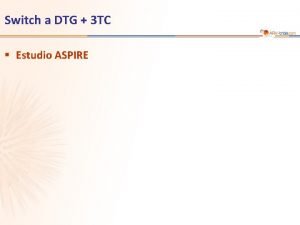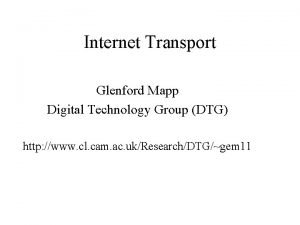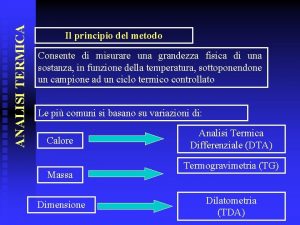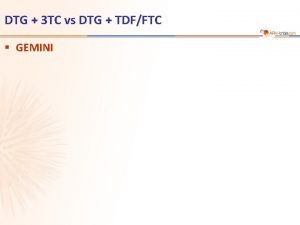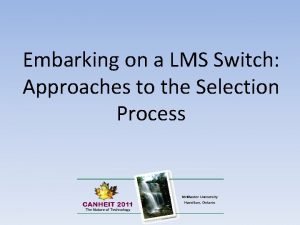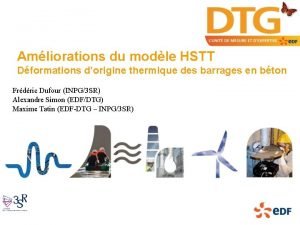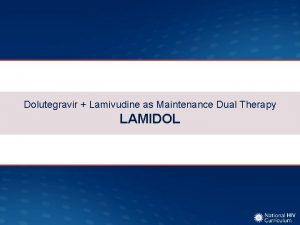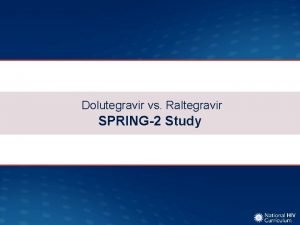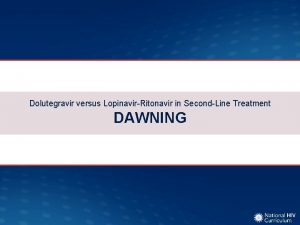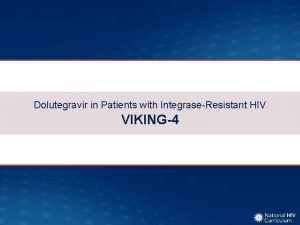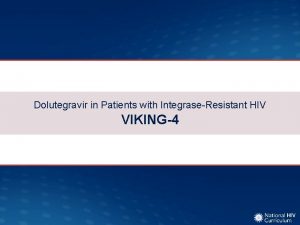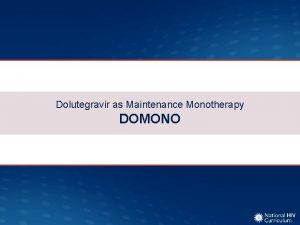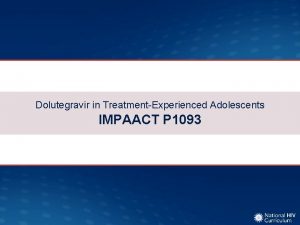Dol PHIN1 Randomised controlled trial of dolutegravir DTG












- Slides: 12

Dol. PHIN-1 : Randomised controlled trial of dolutegravir (DTG)- versus efavirenz (EFV)-based therapy in mothers initiating antiretroviral treatment in late pregnancy C. Orrell, K. Kintu, J. A. Coombs, A. Amara, L. Myer, J. Kaboggoza, B. Simmons, L. Else, C. Heiberg, C. Waitt, S. Walimbwa, E. M. Hodel, A. Hill, S. Khoo, M. Lamorde, on behalf of the Dol. PHIN-1 Study Group ** Research funding and drug donation for Dol. PHIN-1 was provided by Vii. V Healthcare

Background § Around 1. 5 M HIV+ women become pregnant each year § Effective and timely ART has averted 1. 6 M infant infections § In S Africa, around a fifth of HIV+ pregnant women initiate ART late, in 3 rd trimester (T 3) § Late initiation associated with 7 -fold increased risk of MTCT, and doubling of infant mortality in first year Hypothesis: Faster VL declines with DTG may reduce MTCT at birth & during breastfeeding (BF) in HIV+ mothers initiating ART in T 3 Meyers et al. PLo. S ONE 2015; 10(9): e 0138104

Dol. PHIN-1: Dolutegravir in Pregnant HIV mothers and their Neonates NCT 02245022 1 -7 d To comply with guidelines, all subjects start EFV pending randomisation § HIV+ pregnant mums initiating ART in T 3 (28 -36 w gestation) ≥ 18 y, no ARVs in preceding 6 m (no previous INSTIs), no depression, Hb ≥ 8 g/d. L, e. GFR ≥ 50, ALT ≤ 5 x. ULN, no active HBV § Randomised 1: 1 to receive DTG vs EFV until 2 w PP plus TDF/3 TC (Uganda) or TDF/FTC (S Africa). DTG (50 mg/d), EFV (600 mg/d) § Primary endpoint: maternal PK of DTG § Secondary endpoints: plasma VL <50 copies (or undetectable) at PP visit (0 -2 w PP), safety and tolerability, PK in cord blood and BM

Dol. PHIN-1 Enrolment & Baseline Demographics Baseline median (range) DTG (n=29) EFV (n=31) Total (n=60) Age (y) 27 (19 -42) 25 (19 -35) 26 (19 -42) Weight (kg) 68 (45 -103) 65 (48 -119) 66 (45 -119) BMI (kg/m 2) 26 (19 -40) 25 (21 -46) 26 (19 -46) 31 (27 -35) 30 (27 -36) 31 (27 -36) 4 (2 -5) 4 (3 -6) 4 (2 -6) 343 (41 -712) 466 (32 -932) 394 (32 -932) 0 2 (6. 5%) 2 (3. 3%) 5 (17. 2%) 8 (25. 8%) 13 (21. 7%) Est gestation (w) HIV VL log 10 copies CD 4 (cells/mm 3) HBs. Ag +ve * Herbal/traditional medicines * missing data DTG (2) EFV (1) § 60 HIV+ mothers enrolled : DTG (29), EFV (31) § Equally split across both study sites § Median gestation 31 w § No difference in baseline VL, CD 4, previous obstetric history, gestation, BMI § High use of traditional medicines noted

Results – Maternal Plasma PK (T 3 versus PP) DTG ng/m. L (range) AUC 0 -24 h (ng*h/m. L) 324 ng/ml 64 ng/ml T 3 * PP * GMR (n=28) (n=27) (90%CI) 37, 575 0. 95 35, 322 (19, 196 – 67, 922) (14, 933 – 59, 633) (0. 74 – 1. 23) Cmax (ng/m. L) 2, 534 2, 843 0. 91 (1, 462 – 3, 986) (1, 398 – 4, 224) (0. 82 – 1. 01) Ctrough (ng/m. L) 642 696 0. 93 (188 – 3, 088) (204 – 1, 443) (0. 76 – 1. 14) 9/28 (32%) 6/27 (22%) DTG ≤ MEC (324 ng/m. L) * 1 subject with undetectable levels throughout excluded § Rich PK sampling in T 3 and PP § PP sampling (2 -18 d; median 8 d) does not reflect return to normal physiology; exposures not significantly different from T 3 § All but one [DTG] above 64 ng/m. L (PA-IC 90) § In T 3, 9/28 (32%) of [DTG] at or below 324 ng/m. L (MEC) § Maternal: cord blood ratio = 1. 21 (0. 51 – 2. 11) [median (range)] Min et al, AIDS 2011; 25: 1737 Cotterell et al. Clin Pharmacokinet 2013; 52: 981

Results – PK in Breast Milk and Breastfeeding Infants Breast Milk Infant Plasma 64 ng/m. L Breast milk § sampled at maternal plasma Cmax and Ctrough § Geometric mean BMmax 70 (58 – 83) ng/m. L; BMtrough 24 (19 – 29) ng/m. L § BM: MP at Cmax and Ctrough = 0. 03 (3%) Infant plasma § sampled at maternal plasma Ctrough; feed mandated at Cmax and infant sampling 1 h later § Geometric mean IPmax 111 (50 – 172) ng/m. L; IPtrough 87 (47 – 127) ng/m. L § IP: MPmax = 0. 05 (0. 02 – 0. 07) ; IP: MPtrough = 0. 12 (0 – 0. 26) 64 ng/m. L

Results : DTG Washout following Cessation MP vs Breast Milk MP vs Infant Plasma 64 ng/m. L Breast milk § Rapid washout following DTG cessation Infant plasma § Slow washout of DTG in infants following cessation of DTG in mother § Likely reflects accumulation from BF (+/- residual transplacental accumulation) due to decreased glucuronidation in the neonate 64 ng/m. L

Results – Viral load at Post-partum Visit ITT (M=F) DTG (N = 29) EFV (N = 31) P value ** 20 (69. 0%) 12 (38. 7%) 0. 02 9 (31%) 19 (61. 3%) HIV-1 RNA level at PP visit <50 copies/m. L * ≥ 50 copies/m. L * <50 copies/m. L or UD (Roche Ampliprep Cobas Taqman HIV-1 2. 0) ** Pearson Chi-squared Includes individuals missing or discontinued by visit § By ITT, significantly greater proportion of DTG subjects achieved virological suppression at PP (2 w) visit § Median time to HIV-1 RNA <50 copies was approximately halved with DTG compared to EFV § 1 mother in the DTG arm had UD DTG concentrations, with no VL response; another with [DTG] < 64 ng/m. L experienced virological rebound (3 class drug resistance from baseline sample) NRTI: M 41 L, L 210 W, T 215 Y, M 184 V NNRTI: Y 188 L PI: M 46 I, I 84 V, I 54 V, V 32 I, V 82 A, L 33 F, K 43 T

Safety – Maternal outcomes DTG (N = 29) Given birth EFV (N = 31) Total (N = 60) 29 (100. 0%) 31 (100. 0%) 60 (100. 0%) 25 (86. 2%) 4 (13. 8%) 21 (67. 7%) 10 (32. 3%) 46 (76. 7%) 14 (23. 3%) Experiencing at least 1 adverse event Grade ≥ 3 2 (6. 9%) 0 2 (3. 3%) Experiencing at least 1 serious adverse event 2 (6. 9%)§ 1 (3. 2%)* 3 (5. 0%) Mode of delivery, N (%) Normal C-section Maternal AEs and SAEs since starting ART (i. e. includes initial EFV-based ART in mothers subsequently randomised to DTG) 1 case of Haemoglobin decreased (not related); 1 case with Malaria + Urinary tract infection (possibly related), Stillbirth (not related), and ALT+ bilirubin increased + Hypokalaemia + Hyponatraemia (possibly related) * 1 case of Hypertension + Pre-eclampsia (unlikely related) §

Safety – Infant outcomes DTG (N = 29) EFV (N = 31) Total (N = 60) 28 (96. 6%) 1 (3. 4%) - 29 (93. 5%) 2 (6. 5%) 1 (3. 2%) 57 (95. 0%) 1 (1. 7%) 2 (3. 3%) 1 (1. 7%) median (range) 39 (35 -43) 38 (34 -42) 38 (34 -43) median (range) 51 (44 -58) 50 (33 -55) 50 (33 -58) median (range) 3 (2 -4) - 3 (9. 7%)† 3 (5. 0%) Outcome of delivery Normal healthy baby Stillbirth§ Congenital malformation of which syndactyly § Multiple * Gestation age at birth, weeks Length of baby, cm Weight of baby, kg Experiencing at least 1 serious adverse event § Not related * Not related. Multiple skeletal and limb defects (talipes, multiplex arthrogryposis, developmental hip dysplasia, limb hyperextension) Cardiac defects (Atrial septal defect, Persistent left superior vena cava) + cleft palate, hyporeflexia (? Larsen or TARP syndrome) Note: The infant was also pre-term/small for gestational age, and had congenital syphilis. † 2 cases with congenital malformations and 1 case of neonatal sepsis (not related)

Dol. PHIN-1 Conclusions § In this pilot study, a significantly greater proportion of mothers initiating ART late in pregnancy achieved HIV-1 RNA <50 copies/m. L with DTG- compared to EFV- based regimens § DTG exposures in T 3 were relatively low. In-utero accumulation of DTG was high (121%). § Breast milk accumulation of DTG was 3% with higher exposures in breastfed infants, likely due to reduced drug clearance § Upon cessation, DTG was rapidly eliminated from breast milk; however infant washout was prolonged. § Safety of DTG and EFV was comparable; however evaluation is limited by small sample size, relatively short follow-up and by prior EFV use in all DTG mothers initiating ART § Dol. PHIN-2 (NCT 03249181) is a randomised comparison of DTG vs EFV initiation in third trimester (28 w – labour; N = 250).

Acknowledgements We are grateful to all the mothers and families who participated in Dol. PHIN-1 Infectious Diseases Institute Catriona Waitt Helen Reynolds Eva-Maria Hodel Laura Else Alieu Amara Joshua Gini Sujan Dilly Penchala Laura Dickinson Henry Pertinez Adeniyi Olagunju David Back Statistical Support Andrew Hill Bryony Simons Mohammed Lamorde Kenneth Kintu Stephen Walimbwa Julian Kaboggoza Eva Laker Byamugisha Josaphat Andrew Kambugu Pauline Byakika University of Cape Town Catherine Orrell Landon Myer Julie-Anne Coombs Christie Heiberg Ushma Mehta Yashna Singh TSC / IDSMB Graham Taylor Mark Mirochnick Helen Mc. Illeron Polly Clayden We are grateful to Vii. V Healthcare for project funding and donation of DTG for Dol. PHIN-1

